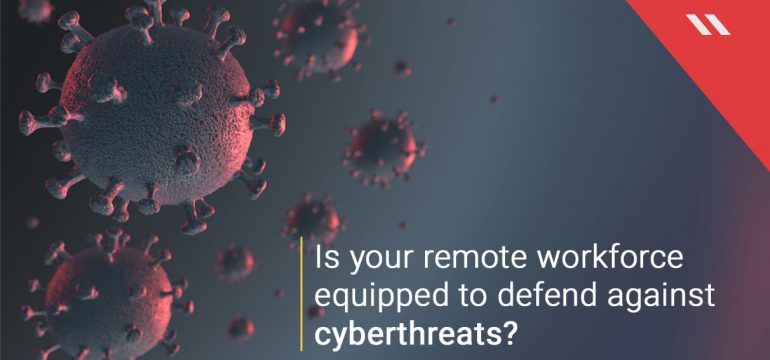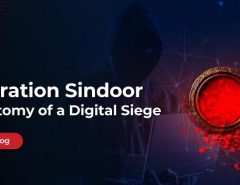The threat is real! The WHO has recently announced that the Coronavirus catastrophe has reached a a pandemic level. Amidst the global chaos, enterprises are in helter-skelter as well, thinking of the best possible ways to retain business continuity and ensure that their employees remain safe and don’t get infected from the lethal virus.
The idea of enabling employees to ‘Work from Home’ seems to be the most obvious and logical decision to achieve the aforementioned objective. However, for enterprises, this is not as easy as it looks. Already, adversaries have strategized coronavirus’ theme mounting a barrage of cyberattacks through phishing emails, et al. The new development has opened a brand new channel for further extortion from employees working from home.
Home networks comprise of a personal internet provision which is not as secure as enterprise networks. Cybersecurity vendors ensure top-notch security by integrating highly advanced protection capabilities in internet grids for businesses. Most employees though are not as proactive as businesses while handling enterprise data on a company or privately owned devices, be it mobiles, desktops or laptops.
Consider the case of a country like India where nearly two million employees have been indefinitely asked to work from home. As per a survey, most of these employees do not have a cybersecurity solution, if working on their device. This is a problem! Every organization cannot provide a company-owned device or a secured network to each employee.
Coronavirus is already looming a shadow of economic slow-down around the globe. A cyberattack is the last thing that businesses are looking for, at this point. On the other hand, the situation of allowing employees to work from home is a must. The scenario per se is a stark contrast where businesses emerging as clear winners are looking bleak.
So how do businesses and employees ensure the safety and security of their data to avoid any disruptions?
The business challenge from a Work from Home perspective
The concept of working from home is not new. However, having your entire workforce remote is a behemoth of an IT challenge. When employees migrate out of secured networks managing the lavish spread of devices becomes nearly impossible. Also, patching and securing unsecured devices and networks is simply back-breaking. The result: IT teams lose control over the new eco-system created due to this phenomenon.
As a part of a contingency plan, nine out of ten organizations are not prepared to handle this new network that now encapsulates employee workspaces. These can be homes, coffee shops, employees working from other cities, co-working spaces and many more. Multiple sectors are still using legacy systems in their core operations which are coupled with unpatched software, proprietary or otherwise, becoming a huge security concern, automatically.
In a nutshell, even a layman can be vocal and exclaim that such software, systems or employees that access the former are not approved for remote work. Legacy constellations are very difficult to patch and manage to make the situation grave. Most of the times such systems need special tweaks to be made available for remote use. Now, SaaS and Cloud adaptations can ease access but the real challenge is if companies using these have a policy of hosting them on internal networks only. In this case, employers can provide access to employees through a VPN or related networking solutions. Companies issuing endpoints themselves, in almost all cases, tag stringent security policies to their devices — IT teams have to take remote control over these devices to fix them.
Lastly, employees are heavily dependent on mobile devices because they can respond faster than say laptops or desktops. All of these aspects open further attack channels. Attackers know this and in situations like the aftermath of the pandemic are bound to take maximum advantage.
Best practices when working remotely
Cybersecurity mock-drill
Enterprises stakeholders need to step-up and include a remote-work exercise for their employees. Security leaders need to chip-in about ‘Do’s and Don’t’s’ when working from home.
Taking stock of enterprise applications
Businesses should make a complete list of applications used in day-to-day operations and identify the mission-critical ones. Next, these apps need to be segregated into on-premise and SaaS categories. Enterprises should then get into a thorough discussion with SaaS vendors about the business continuity stamina of such apps. For on-premise, the strength of VPNs or other networking solutions needs to be tested extensively.
Employee inventory
A detailed list of endpoints that employees will be using while working remotely is mandatory along with their connection methods to business-data. This helps in the pre-planning of troubleshooting in case of a red-flagged event.
Zero-trust adoption
One cannot replace legacy systems immediately — increased VPN adds-in to cost. The idea of Zero-trust adoption will work well here considering that it will propel the use of cloud-based services and eliminate VPN dependency.
Employee cybersecurity literacy
Lastly, employees need to be educated on the best practices in cybersecurity. If they practice caution when dealing with critical data, it will help in drastically reducing the possibility of cyberattacks. Considering that a lot of attacks are predicted to happen from phishing campaigns, employees need to be alert while opening links or attachments from unsolicited sources. For, BYOD, enterprises need to deploy a secured container to hold enterprise data, However, for employees using their laptop, they need to ensure that a secured home Wi-Fi router becomes their first line of defence.
Seqrite’s enterprise defence arsenal
Seqrite, the enterprise arm of the custodians of cybersecurity, Quick Heal Technologies, has a wide range of products developed to cover every threat vector that may arise as a result of employees working from home.
Seqrite Endpoint Security Cloud
While regular Endpoint Security solutions (EPS) only work when laptops & desktops are on-premise the Seqrite EPS Cloud helps endpoint management off-premises through the Cloud. The functionality allows Work From Home IT Admins to manage enterprise endpoints location-agnostically. This ensures round-the-clock endpoint protection from anywhere at any time.
Data Loss Prevention (DLP)
Embedded as a core capability in Seqrite’s Endpoint Security Solution, it enforces policies regarding the use of storage devices. These can be mobile and portable devices, wireless devices, network interfaces connected to endpoints, et al. DLP prevents data loss by monitoring confidential and user-defined data shared through removable drives, network or various applications. This keeps the integrity of enterprise allocated endpoints to employees intact.
Seqrite Device Management
mSuite, Seqrite’s flagship mobile device management platform encapsulates the end-to-end of enterprise mobility. Businesses can reap huge benefits in critical remote work scenarios like the one happening now, due to Covid-19. Be it company-given or personally owned, mSuite’s capabilities equip enterprises for total device management, on-premise or off-premise. mSuite is designed on four critical pillars, i.e. mobile device management (MDM), identity & access management, mobile content management, and mobile application management giving businesses the edge, especially during remote working situations.
Seqrite Workspace
Seqrite Workspace, a pivotal add-on to the mSuite, is the most powerful solution to protect enterprise data on employees’ devices. BYOD or Bring Your Own Device is a popular trend currently allowing employees access to business data on their devices. Working outside office perimeters automatically cascades to employees increasingly working from their handsets. This, in turn, results into vulnerable, lost, stolen or misplaced devices jeopardizing business-specific data. Workspace resolves this problem by integrating a robust container inside employee devices equipped with capabilities such as remote-wipe, SSO and the inability to extract information outside the secured container. This sustains a safe BYOD, especially during work from home scenarios.
Unified Threat Management (UTM)
We discussed Work From Home scenarios as impossible without the use of a Virtual Private Network (VPN) and how it can become a legitimate channel for cyberattacks. It is common knowledge that VPNs permit employees to access enterprise networks through endpoints. However, without a robust firewall, the enterprise ecosystem, which in a macro-view is endpoints and networks, is in danger. Keeping this in mind, businesses can leverage Seqrite’s UTM that boasts of one of the best Firewalls observed in the cybersecurity sphere. With its several other features made to protect networks from myriad cyberthreats, the UTM is a must-have product.
Seqrite Encryption Manager (SEM)
The Seqrite Encryption Manager (SEM) is a comprehensive encryption suite offering robust data protection for desktops, laptops and servers, off-premise or on-premise. The product is compliant with international data protection laws. The product encrypts drives inside computers with military-grade and industry-best technologies that hackers cannot extract enterprise data from computers. SEM then becomes a sought after product simply because enterprises can effortlessly safeguard data in case of employees losing their computers when working remotely. It saves time and the need to investigate losing a device benefitting businesses hugely.
Access this weblink to get in touch with us.
The Coronavirus is undoubtedly a sad event and a major global catastrophe. However, humanity needs to ensure that it stops at that and does not cause additional repercussions such as cyber threats. Its time for businesses to put the pedal to the floor to safeguard their enterprise.




